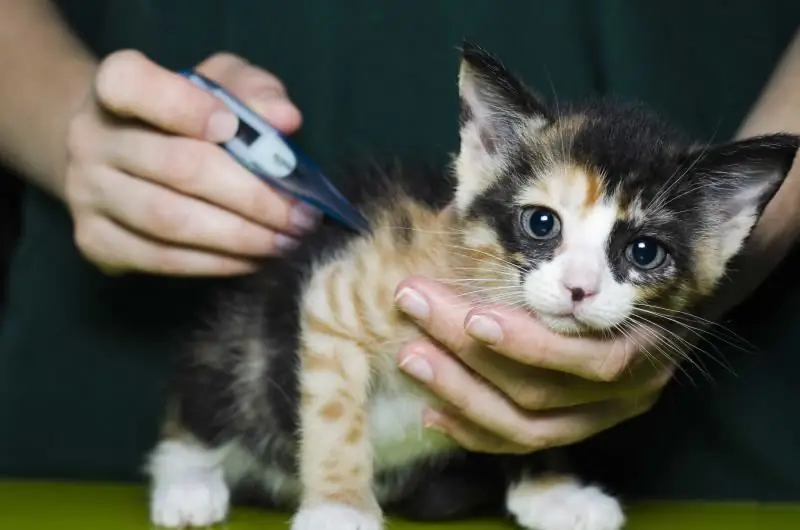
Table of contents:
- Feline eosinophilic granulomas: identify and treat
- What is eosinophilic granuloma in cats
- Forms of eosinophilic granulomas
- Common symptoms of eosinophilic granuloma
- Possible consequences and complications, prognosis
- Diagnostics of the eosinophilic granuloma of cats
- When you need to urgently see a veterinarian
- Treatment of feline eosinophilic granulomas at home
- Medication for feline eosinophilic granuloma
- Are folk remedies used in the treatment of eosinophilic granulomas
- Rules for caring for sick animals
- Features of the treatment of pregnant cats and kittens
- Prevention
- Author Bailey Albertson [email protected].
- Public 2024-01-17 22:26.
- Last modified 2025-06-01 07:32.
Feline eosinophilic granulomas: identify and treat

Feline eosinophilic granuloma is a group of skin diseases that is common but poorly understood. It is important to notice danger signs in an animal and seek veterinarian help in time to ensure that the sick cat receives appropriate, often lifelong treatment.
Content
-
1 What is eosinophilic granuloma in cats
1.1 Factors contributing to the development of the disease
-
2 Forms of eosinophilic granulomas
-
2.1 Indolent (flaccid) ulcer
2.1.1 Photo Gallery: Indolent Ulcer in Cats
-
2.2 Eosinophilic granuloma
2.2.1 Photo Gallery: Eosinophilic Granuloma in Cats
-
2.3 Eosinophilic plaque
2.3.1 Photo Gallery: Eosinophilic Plaque in Felines
-
- 3 Common symptoms of eosinophilic granuloma
- 4 Possible consequences and complications, prognosis
- 5 Diagnosis of feline eosinophilic granuloma
-
6 When you need to urgently contact the veterinarian
6.1 Surgical treatment of feline eosinophilic granulomas
- 7 Treatment of feline eosinophilic granulomas at home
-
8 Drug treatment for feline eosinophilic granulomas
-
8.1 Anti-inflammatory and immunosuppressive therapy
- 8.1.1 Table: Cost of Different Types of Corticosteroids
- 8.1.2 Table: Injectable Corticosteroid Prices
- 8.2 Antibiotic therapy
- 8.3 Local therapy
-
- 9 Are folk remedies used in the treatment of eosinophilic granulomas
-
10 Rules for caring for sick animals
10.1 Diet
- 11 Features of the treatment of pregnant cats and kittens
-
12 Prevention
12.1 Danger to people and other domestic animals
What is eosinophilic granuloma in cats
Eosinophilic granuloma of cats is an allergic disease. It is based on the inability of eosinophils (white blood cells) to provide a normal immune response to an allergen. Eosinophils accumulate in limited areas of the skin or mucous membrane, form and maintain a focus of specific inflammation. This is how eosinophilic granulomas are formed. With the course of the disease, the surrounding tissues are further involved in the inflammatory process. When a microbial secondary infection is attached, inflammation increases.
Dysfunction of eosinophils is congenital. Granulomas most commonly occur in cats 3-5 years old. In cats, it appears somewhat less frequently. No breed predisposition has been identified. Foreign sources carefully mention that, possibly, Norwegian forest cats are predisposed to the disease.
Factors contributing to the development of the disease
There are a number of factors that are most often triggers in the development of the disease:
- an allergic reaction to insect bites (ticks, mosquitoes, fleas);
- endoparasites (various helminthiases);
- environmental allergens (plant pollen, plastic bowls);
- an allergic reaction to medications;
- fungal, viral infections.
In some cases, there are manifestations of eosinophilic granulomas, and the effect of triggering factors on the cat is excluded. Such cases are considered idiopathic.
Forms of eosinophilic granulomas
Feline eosinophilic granulomas appear in a number of forms. They are typical and well recognized by specialists. There are such forms:
- indolent (flaccid) ulcer;
- eosinophilic granuloma;
- eosinophilic plaque.
Since they are different manifestations of the same allergic disease, they are often referred to as the eosinophilic granuloma complex. Forms can be present in one cat both individually and in various combinations. The possibility of transition of granulomas to plaque is noted.
Indolent (flaccid) ulcer
It is characterized by location on one or both upper lips and spread from the skin to the mucous membrane. It looks like an erosion or ulcer with well-defined borders and raised edges. Color - brownish-yellowish, sometimes whitish blotches of necrosis are noticeable. It doesn't bleed, itch, or hurt. The size and depth of the ulcer depends on the stage of the disease. Inflammatory infiltration causes swelling and deformation of the lip, sometimes damaging the surrounding tissue.
Photo gallery: indolent ulcer in cats
-

Indolent lower lip ulcer in a cat -
Indolent ulcer of the lower lip manifests itself as edema
-

Indolent upper lip ulcer in a cat - With prolonged course of bilateral indolent ulcer in a cat, the lip is deformed
-

Extensive chronic indolent ulcer in a cat - Extensive chronic indolent ulcer involving the upper lips and mucous membrane, accompanied by necrosis and destruction of parts of the lips
Eosinophilic granuloma
Eosinophilic granulomas in the mouth appear as whitish nodules and bumps on the palate, tongue, and floor of the mouth. Sometimes their surface is covered with erosion. When localized on the chin, it forms the so-called fat chin - swelling, the hair sometimes falls out and the skin shines. When located on the paws, it is a dense formation that causes severe itching, defined in the thickness of the paw pads or in the interdigital spaces. On the sides, abdomen, lower surface of the thighs, it forms very characteristic intradermal thickenings of a linear shape - granulomas. Their color ranges from light pink to yellow-pink. Itching and soreness varies; in some cases it may be severe, while in others it may be practically absent.
Photo gallery: eosinophilic granuloma in cats
-

Eosinophilic granuloma of linear form in a cat - A linear granuloma of the inner thigh looks like an intradermal thickening
-

Feline oral eosinophilic granuloma - With eosinophilic granulomas, granulomatous masses may appear on the cat's tongue
-

Eosinophilic granuloma of cat paw pads - Eosinophilic pododermatitis, edema and erosive granulomas also appear on the paws
Eosinophilic plaque
Eosinophilic plaque is a severely itchy eroded area with clear boundaries. It rises above the surface of the skin, is moist, shiny and has no hair on it. Any localization is possible, but the most typical location is on the stomach, groin, and the inner and back of the thighs. Adjacent lesions may coalesce, increasing the area of the eroded surface. The soreness of the eosinophilic plaque is described by the authors as unexpressed, but it is absolutely certain that with infection and the inevitable scratching, the pain sensations will become distinct.
Photo gallery: eosinophilic plaque in cats
-

Eosinophilic plaque on the inner thigh of a cat - The typical location of an eosinophilic plaque is on the inner thigh
-

Group of small eosinophilic plaques - A group of small eosinophilic plaques have a tendency to fusion
-

Eroded surface on a cat's paw - Eosinophilic plaques usually appear in cats on the belly, groin, and thighs
Common symptoms of eosinophilic granuloma
The symptoms of the disease are determined by several factors:
- the degree of activity of the allergic process and the duration of its course;
- the severity of signs of secondary, already bacterial inflammation;
- triggering factors, such as the manifestation of a fungal infection of the skin or scabies.
Common symptoms are not specific. Such manifestations are possible:
- the reaction of regional lymph nodes: if at the beginning of the disease it is absent or there is a slight change in the lymph nodes, then with the development of the disease, the increase in the area of the lesion and the addition of the bacterial flora, the lymph nodes increase, become dense, painful, merge into bags;
- the development of purulent lymphadenitis in severe cases: with the development of intoxication accompanying bacterial inflammation, an increase in body temperature, lethargy, deterioration in appetite and activity of the cat is possible;
- a decrease in body weight in violation of chewing and swallowing with localization of granulomatous growths in the mouth, eosinophilic lesions of the digestive tract or chronic intoxication with pyoderma;
- specific damage to the digestive system with a prolonged course of the disease and the absence of treatment - the development of eosinophilic gastritis and enteritis;
- in advanced cases - enlargement of the liver, spleen, peripheral lymph nodes that are not regional for the focus of granuloma;
- in laboratory analyzes, eosinophilia in the peripheral blood always draws attention to 20%, there may be a decrease in total protein, with a long course of the disease, hypegammaglobulinemia is observed in the proteinogram, and some authors indicate a persistent increase in amylase indices.
Possible consequences and complications, prognosis
If the cat does not receive treatment at the stages of local manifestation of the disease, allergic miliary dermatitis and eosinophilic gastritis may develop, which reflect the increased involvement of dysfunctional eosinophils in the pathological process:
- Allergic miliary dermatitis, or eczema. It manifests itself in the smallest, millet-like rashes in the form of bubbles and tubercles throughout the body, redness of the affected areas, intense itching. The formation of the smallest erosion is characteristic, then scabs, which merge. The coat is thinning and falling out. In the chronic course of the disease, the places of redness are replaced by dark pigmentation, and black acanthosis is formed. There is a high risk of infection during calculations and the development of secondary pyoderma. In common parlance, the condition is called scab.
- Eosinophilic gastritis and enteritis. Eosinophilic infiltration of the stomach wall and small intestine occurs. The intestinal loops are thickened, expanded. Animals lose weight, the stool is not decorated, often with an admixture of blood. Frequent vomiting is possible.
The most common complication is secondary pyoderma - infection and suppuration of the affected areas. Her signs:
- cloudy discharge appears, pain grows;
- swelling and redness spreads to surrounding tissues;
- body temperature rises;
- the reaction from the regional lymph nodes is expressed in the form of their enlargement and pain on palpation;
- the general well-being of the cat worsens due to the growing intoxication.
The prognosis for cats in which an allergen is identified and it is possible to exclude contact with it is favorable: the disease after treatment goes away without a trace. In other cases, you will need long-term and repeated therapy, frequent outpatient monitoring. The lack of response to the treatment, as well as the appearance of adverse reactions to therapy, worsen the prognosis. Veterinary care increases the period of remission to 6-8 months, improves the quality of life, and also maintains its duration at the usual level for cats.
Diagnostics of the eosinophilic granuloma of cats
Given the characteristic manifestations, competent cat owners will no doubt suspect eosinophilic granulomas. This will give you the advantage of seeing your veterinarian early. It is impossible to make a diagnosis on your own. For this, an examination, collection of anamnesis and a set of laboratory studies are carried out. But it is also required to exclude diagnoses with similar manifestations. Only then, relying on the results obtained, begin the choice of therapy.
Diagnosis begins with anamnesis:
- It is established when the first manifestations of the disease appeared, what they looked like, what preceded it, whether there is a hereditary predisposition to the pathology of the immune system.
- The presence of invasions of worms, fleas, ticks, as well as fungal and viral infections is specified.
- The diet is analyzed and the impact of external allergic factors is studied.
- The doctor searches for and isolates the trigger - the factor that triggered the disease. The closest attention is to be paid to this. To search for an allergen in the external environment, skin allergy tests are used.
After that, diseases with similar symptoms must be excluded:
- tumors, especially squamous cell carcinoma;
- lupus of the skin;
- viral, fungal, mycobacterial infections;
- drug reactions;
- burns with caustic substances;
- bites from other animals;
- thermal damage.
To verify the diagnosis, a dermatological examination of the skin is performed. Volumetric granulomatous formations are examined by fine-needle aspiration biopsy. Material is removed from ulcerative defects by scrapings. In the cytological material with eosinophilic granulomas, many eosinophils, histiocytes are determined. You can also do bacteriological culture to determine the sensitivity to antibiotics, if necessary.

It is impossible to independently establish the presence of eosinophilic granulomas, the help of a veterinarian is needed
The doctor draws blood for general and biochemical analysis. There are no manifestations specific to granulomas in it, but the analysis is required to collect information about the functional state of the cat's body, as well as to identify metabolic disorders - renal failure, diabetes mellitus, liver failure. This certainly reduces the physician's therapeutic arsenal, but protects the cat from the complications of therapy. If necessary, the veterinarian prescribes a urinalysis, ultrasound of the internal organs.
When you need to urgently see a veterinarian
An urgent appeal to the veterinarian is necessary:
- if an eosinophilic granuloma is suspected: the earlier the doctor sees the cat, the easier the treatment and the better the prognosis;
- if there is no effect of the treatment being carried out within the expected time frame, the same size of damage, pain, itching remains: perhaps the treatment did not fit;
- when signs of inflammation appear or intensify: opportunistic bacterial flora may join;
- with the development of side effects and complications of treatment - they are usually warned about, prescribing one or another type of therapy;
- when a cat's health condition changes due to the action of extraneous factors, for example, accidental poisoning with vomiting during treatment with pills: therapy cannot be interrupted, in order to change the dosage form of the drug, consult a doctor;
- with any negative change in the cat's health.
Surgical treatment of feline eosinophilic granulomas
Since eosinophilic granuloma is a systemic disease, the priority remains with drug therapy. Surgical treatment is indicated in the case of resistance to the therapy of single large plaques and granulomas. This can be excision with a scalpel, laser vaporization or cryodestruction. With surgical treatment, relapses are often noted. Before him, it is desirable to sanitize the plaque with antiseptic solutions to prevent the spread of infection to the surrounding tissues during manipulation.
Treatment of feline eosinophilic granulomas at home
Home treatment is solely the fulfillment of a veterinarian's prescription. The following recommendations are usually given:
- at the very beginning of the treatment, protect the cat from self-harm by scratching and licking: ensure the presence of soft polymer pads on the claws, protective overalls, protective "Elizabethan" collar;
- if the trigger factor has already been identified, then protect the cat from its influence, for example, from mosquito bites;
- give the animal medications prescribed by the veterinarian;
- carry out local treatment using solutions and ointments as directed by a veterinarian;
- provide special feeding for the cat (useful for food allergies or underweight);
- monitor the cat's condition in dynamics;
- Bring the cat to the vet for check-ups.

To avoid scratching and infection of skin lesions, use a protective collar
Medication for feline eosinophilic granuloma
In drug treatment, the following areas are distinguished:
- etiotropic therapy - aimed at eliminating the factor that caused the allergy, for example, the treatment of demodicosis or deworming;
- anti-inflammatory, immunosuppressive therapy - suppression of the pathological reaction of the immune system;
- antibiotic therapy - prescribed if there is a secondary bacterial infection;
- symptomatic therapy - aimed at improving the functioning of organs;
- local therapy - applying solutions and ointments directly to the skin.
Depending on the situation, the veterinarian combines the directions, making an individual treatment program for each cat. Medicines used for etiotropic and symptomatic therapy are diverse, and the composition of medicines for anti-inflammatory, antibacterial and local therapy is constant.
Anti-inflammatory and immunosuppressive therapy
Two types of medications are used:
-
Corticosteroids. They provide a rapid anti-inflammatory, anti-edema and antipruritic effect, reduce cellular infiltrates in the foci of inflammation and block the release of inflammatory mediators by cells. Applicable:
- prednisolone tablets 1-2 mg / kg every 12-24 hours, followed by a gradual increase in the interval to 48-72 hours - it is important to continue treatment even after the signs of granuloma disappear for at least a week;
-
analogs of prednisolone tablets:
- methylprednisolone (0.8 doses of prednisolone);
- dexamethasone (0.15 doses of prednisone);
- triamcinolone (0.25-0.8 doses of prednisolone);
-
injectable forms of corticosteroids (effective, the effect manifests itself within the next 24-48 hours and lasts from several days to weeks, but the risk of developing immunosuppression and diabetes mellitus with the use of prolonged forms is higher than with the use of tablets):
- dexamethasone s / c, i / m (Dexafort 0.3 - 0.7 ml per cat);
- methylprednisolone acetate i.m. (Depo-Medrol 0.25 - 0.5 ml per cat);
- triamcinolone (Kenalog IM 0.2 - 0.5 ml per cat).
-
Cytostatics (immunosuppressants). If the manifestations of eosinophilic granulomas return with a decrease in the dose and frequency of administration of corticosteroids, then they switch to combination therapy with cytostatics. Their action is aimed at suppressing pathological cell division. Using them for granulomas, they expect to suppress the formation of eosinophils in the bone marrow. They are characterized by side effects from the digestive system (nausea, vomiting, diarrhea), as well as from the side of bone marrow hematopoiesis (platelets are the first to suffer). Therefore, it is necessary to closely monitor the condition of the cat and prepare for the delivery of control blood tests. It is important to have time to cancel therapy if complications begin to develop. Used by:
- chlorambucil in doses of 0.1-0.2 mg / kg (2-4 mg / m2 of body surface) daily or every other day, symptoms of gastrointestinal tract damage - anorexia, vomiting, diarrhea - occur less frequently when administered every other day, and depression hematopoiesis passes after the drug is discontinued (the course is 1-2 months, then the dose is reduced until the drug is discontinued);
- cyclosporine at a dose of 2.5 mg / kg / day - when a response to therapy is achieved, the dose is gradually reduced until it is completely canceled.

When treating eosinophilic granulomas, veterinarians prescribe prednisolone in the form of tablets or injections
The selection of a corticosteroid should be based on its effectiveness in the particular cat. When treating animals with drugs of this group, it is recommended to control the clinical blood test, including platelet count, every 2 weeks.
Table: the cost of different types of corticosteroids
| A drug | Prednisolone 5 mg No. 100 (Gedeon Richter) | Methylprednisolone 4 mg No. 30 (Metipred, Orion) | Dexamethasone 0.5 mg No. 10 (KRKA) | Triamcinolone 4 mg No. 50 (Polcortolone, Polfa) |
| Price in a pharmacy, rubles | 108 | 201 | 45 | 356 |
| Cost of treatment for one day of a cat weighing 5 kg in a therapeutic dose, rubles | 2.16 | 13.4 | 13.5 | up to 14.24 |
The most affordable drug is Prednisolone. Its advantage is the presence of a dosage of 1 mg, since maintenance dosages below the therapeutic ones are inconvenient. When comparing the prices of injectable long-acting corticosteroids, the price of the dose in milliliters or ampoules is taken. The contents of the ampoule after dialing the required amount of the drug are not stored.
Table: prices of injectable corticosteroids
| A drug | Dexafort 50 ml | Depo-Medrol 1 ml No. 1 | Kenalog 1 ml No. 5 |
| Price in a pharmacy, rubles | 1073 | 77.5 | 450 |
| Dose or ampoule price, rubles | 15.022 | 77.5 | 90 |
Antibacterial therapy
In case of infection of the skin manifestations of eosinophilic granulomas, which is facilitated by itching followed by scratching, as well as in chronic ulcers, systemic antibiotic therapy is required. Broad-spectrum antibiotics are used:
- amoxicillin + clavulanate - 12.5-25 mg / kg po every 12 hours;
- cephalexin - 25 mg / kg po every 12 hours;
- enrofloxacin - 5-10 mg / kg po every 12 hours;
- other drugs.
In chronic cases, suspected resistance to antibiotic therapy, as well as the development of opportunistic flora, the material is sent for microbiological examination (isolation of bacterial and fungal cultures and antibiotic sensitivity test).

Chronic ulcers should be treated with antibiotics such as Cephalexin
Local therapy
It is of secondary importance. It consists in applying antiseptic solutions to the skin lesions (Miramistin, Povidone-iodine, Chlorhexidine aqueous solution), as well as ointments containing corticosteroids. Without systemic antibiotic therapy, only erosion is eliminated by local exposure.
Are folk remedies used in the treatment of eosinophilic granulomas
It is strictly forbidden to use any means, including folk remedies, not agreed with the veterinarian. An additional allergic load on the cat's body, which is already in a state of pathological excessive immune response, is unacceptable. In the best case, nothing will happen, in the worst case, the immune response can expand, for example, miliary dermatitis will join an indolent ulcer. This will significantly aggravate the cat's condition, complicate treatment and worsen the prognosis of the disease.
Rules for caring for sick animals
The main thing in grooming is to reliably protect the cat from the action of factors that triggered immune restructuring. It is important to carefully follow the medication regimen (corticosteroids are given at the same time), control tests and veterinarian visits. Also, do the following:
- replace the litter in the cat's tray with a hypoallergenic one, as well as its dishes and a bed;
- protect the cat from self-harm, feed it correctly, keep the room and the cat itself clean;
- treat the cat from fleas, ticks, worms;
- restrict the cat's freedom of movement if it is walking on its own - this will protect the cat from eating found food, re-infestation with fleas, worms and ticks, as well as from disrupting the medication regimen;
- watch the cat, keep a diary, take photos;
- treat skin lesions with ointments or antiseptic solutions.

When caring for a cat with eosinophilic granuloma, treatment is carried out for helminths, fleas, ticks
Diet
Nutrition is of great importance, because in cases where the granuloma is caused by food allergies, the diet takes on the importance of etiotropic therapy and its observance provides a cure for the cat. In this case, it is better to use hypoallergenic food of veterinary lines from trusted manufacturers: Royal Canin, Hills and others. If the cat is naturally fed, then she should receive food that she has not received before. For example, the first week is rabbit meat, the second is elk, the third is turkey, and the fourth is lamb. All this time the cat should be watched. Limiting fat in a cat's food is of great importance, since pancreatitis easily occurs during therapy with corticosteroids. In no case should you treat the cat from the table. Long-term ill cats may develop a body weight deficit: their food should contain a sufficient amount of protein - meat, fish, poultry, low-fat cottage cheese.
Features of the treatment of pregnant cats and kittens
Taking corticosteroids, cytostatics and antibiotics is incompatible with pregnancy and breastfeeding. The correct solution is to spay the sick animal. If the cat is already pregnant, you should check with your veterinarian if it is possible to postpone therapy until delivery. Next, you will have to deal with the issue of breastfeeding kittens. Here, the doctor will assess the cat's health and the risks of starting therapy later and possibly allow feeding. Otherwise, the kittens will have to be fed artificially or with the help of another lactating cat. A sick pregnant cat must be monitored by a veterinarian, since it is important to exclude the effect of an allergy trigger. For example, if it is a food factor, then switching to a hypoallergenic diet will significantly improve her condition. Of course, the doctor will not be able to prescribe most of the medications, but he will find other ways to help the cat. For kittens, eosinophilic granulomas are not typical, since for its development there must be prolonged contact with the allergen. From childhood, kittens prone to the development of this disease may develop allergic reactions that cannot be ignored.

If the mother cat has eosinophilic granulomas, kittens are most often fed artificially
Prevention
The main thing is to prevent the development of an allergic reaction in cats. If it already exists, every effort must be made to identify its source and isolate it from the cat, since eosinophilic granuloma is an extreme manifestation of the body's hypersensitivity and it once began with a simple allergic reaction. Be sure to show your cat to your veterinarian, who will prescribe a course of treatment to stabilize the immune system and reduce further risk of developing eosinophilic granulomas. Treatment of a cat from fleas, ticks, worms, as well as timely treatment of fungal and viral infections are important. Prophylactic examinations of a veterinarian are of great importance, since some of the allergic reactions in cats can proceed unnoticed by the owners, but the doctor will definitely pay attention to them. Compliance with the general rules for keeping a cat, together with attention to its health, is already an effective protective factor.
Danger to people and other pets
The danger can be represented by infestations (mites, worms, scabies) or infections (viruses, fungi) that triggered an allergy. By itself, eosinophilic granuloma is harmless and non-infectious to others, since its manifestations are an individual pathological reaction of the immune system to a specific allergen, as well as complications of this reaction. If the triggering factor was an invasion or infection, after its elimination, the skin manifestations in the cat do not pose any danger. On the other hand, a cat being treated with corticosteroids or cytostatics has a drug-induced decrease in immunity and it is recommended to limit the circle of her contacts in order to reduce the risks of infectious diseases.
It is important to recognize the signs of eosinophilic granulomas in a cat in time. Checking up with your veterinarian and being considerate of your pet will help you do this. Timely treatment will improve the quality of life of a sick animal or even help him completely get rid of the disease.
Recommended:
Leukemia (viral Leukemia) In Cats: Causes, Main Symptoms Of The Disease, Treatment And Prognosis Of Survival, Recommendations Of Veterinarians
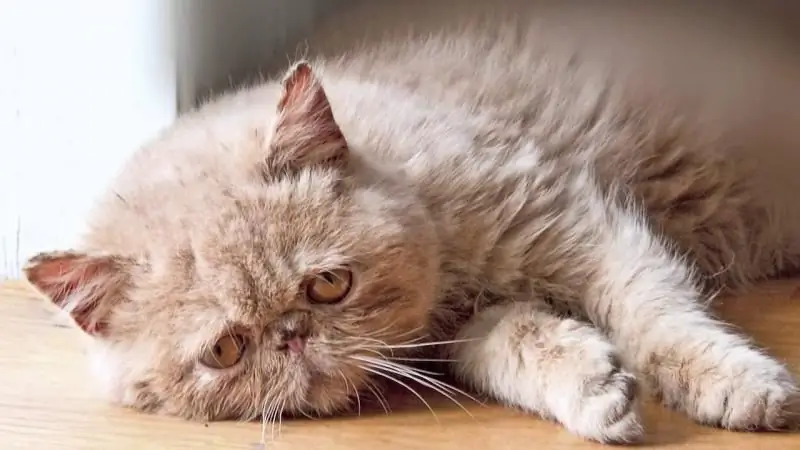
Causes of viral leukemia in cats Infection routes. How does the disease manifest? Diagnostics and treatment. Forecast. Preventive measures. Veterinarian recommendations
Immunodeficiency In Cats: Which Virus Causes The Disease, Main Symptoms, Treatment And Prognosis Of Survival, Recommendations Of Veterinarians
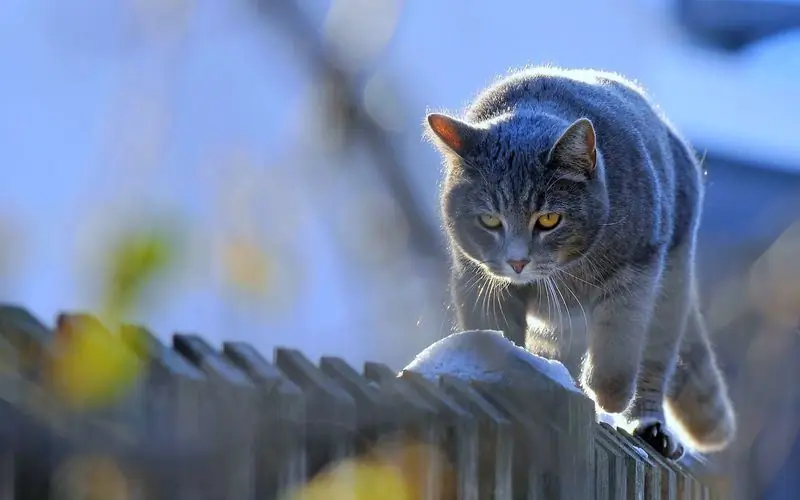
The causative agent of viral immunodeficiency in cats. Infection routes. How it manifests itself. Diagnostics. Treatment and care. Review of drugs. Forecast, prevention
Renal Failure In Cats And Cats: Symptoms, Treatment, How To Save A Kitten And An Adult Animal (recommendations Of Veterinarians)
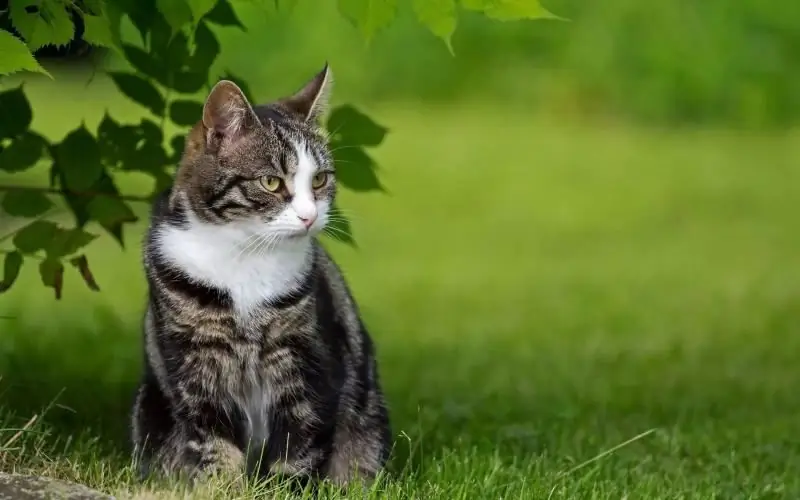
Types of renal failure in cats The reasons for its development. How pathology manifests itself and is diagnosed. Inpatient and home treatment. Prevention
Enteritis In Cats: Symptoms, Diagnosis And Treatment (including At Home), Prevention, Recommendations Of Veterinarians
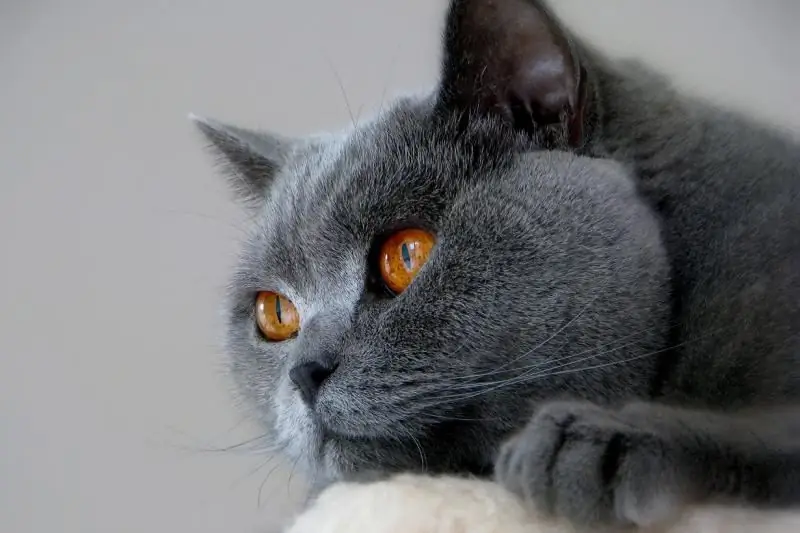
What is viral enteritis. Infection routes. Types of the disease. When to see your veterinarian. How to treat at home. Prevention. Doctor's advice
Diseases Of The Eyes In Cats: Photos Of Symptoms, Diagnosis And Treatment (including At Home), Recommendations Of Veterinarians

What eye diseases are found in cats? How do they manifest. Treatment rules. Animal care during therapy. Prevention. Veterinarian recommendations
